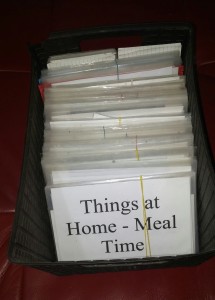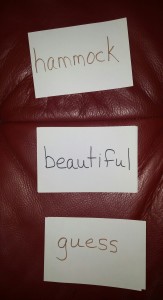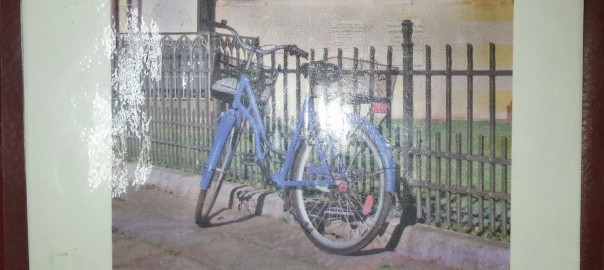A favorite activity of our four year old, one that he requests at least once a day is…. flashcards.
Yes, really. Flashcards. I know, you wouldn’t expect flashcards to be so compelling, right? 🙂 But he really likes them!
I started using these when Yirmi was 14 months old. I began by printing out words and pictures from the Brill Kids Little Reader computer program; each card is the size of half of an A4 sheet of paper. One side has the word printed on it in a large font, the other side has a color illustration of the word.
Over time I printed out a number of these sets and laminated them. Sets include categories like foods, colors, transportation, nature, seasons, parts of the body, and household items. Ideally I would have used these systematically several times a day, using one set a week and switching out an old word for a new word each day. Sometimes I did more and sometimes I did less, and I reminded myself that whatever I did was of value. I found it easiest for me to do first thing in the day since it was before I got distracted with with lots of other things.

As a very relaxed homeschooler, it might seem strange that I would embrace something so seemingly formal as a learning tool. However, if we approach something as a fun and enjoyable activity without the heavy weight of expectations, kids will often perceive the activity as fun and enjoyable – regardless of how ‘schooly’ it might seem.
I use flashcards as a tool to teach reading and support language development, language comprehension and speech development. The brain grows from use! Stimulation and input are very important to a child. Don’t get caught up in looking for visible results – if you’re sharing quality information, it’s beneficial whether you see tangible results or not! (I don’t know what Yirmi’s reading ability is since I don’t test him, but there’s no question his receptive language is excellent.)
When I introduce new words, I explain what the word means and how it is used. So he can tell you, for example, that a ‘stethoscope’ is used to listen to your heart. Usually the words are nouns or verbs and are pretty easy to explain; some are harder concepts like ‘hibernation’, ‘relaxation’ and ‘humidity’ but I do my best. 🙂
Once he’s familiar with the words, I don’t explain them each time we look at the card. I read the the word printed on the front, then turn it over, saying the word again while looking at the picture, then turn it back to the word and reading the word out loud again. It’s a fairly quick process.
 As Yirmi got older, we moved onto cards that were smaller, the size of standard index cards. In the summer I finally shifted away from using printed picture cards and now the new cards I prepare only have the word handwritten on one side.
As Yirmi got older, we moved onto cards that were smaller, the size of standard index cards. In the summer I finally shifted away from using printed picture cards and now the new cards I prepare only have the word handwritten on one side.
While I considered this option from the beginning, I felt it would be more enjoyable and better for comprehension to have the pictures on the back side of the card. The only downside of that approach was that it took much more time to prepare the cards and I didn’t prepare nearly as many as I would have without needing to go to that effort – we have only about 300 or so cards with pictures.
What I do now is super simple. Using a dark marker, I write the word in large print on a small white index card. Recently I went through a children’s book he enjoys and picked out words that we don’t yet have in our sets; preparing the new set of 32 cards took about fifteen minutes!
Most days we ‘do words’, as we call it, once a day. I’ve kept it a relaxed and positive experience both of us. For Yirmi, it means I follow his lead as to which group of words he wants to read together and stop before he’s ready to stop. I want to keep it fun; I don’t quiz him and I don’t turn it into something he’s ‘supposed’ to do. For me keeping it relaxed means letting go of the voices that tell me I’m not doing it right by not doing it more often or in a certain order. Just like I tell you that it’s important to let go of beating yourself up with unrealistic expectations, that’s what I tell myself!
Yirmi has recently been repeating the words as I flash them, so it’s been a great speech opportunity (he has an expressive speech delay called apraxia). I now slow down as I read the word and ennunciate the word clearly and slowly, techniques we’ve all picked up from the Gemiini video modeling program that he uses daily for speech.
We enjoy reading flashcards together, snuggled up on the couch or in my bed – it’s nice that we can integrate something so beneficial so easily!
Avivah



Leave a Reply